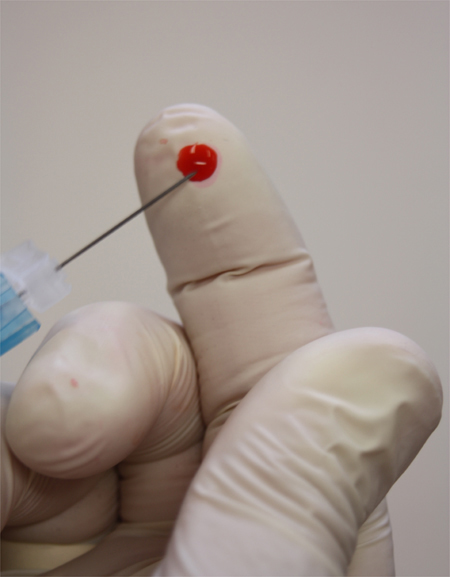Accidental Exposure:
Practices That Put You at Risk.
 An accidental needlestick should never be accepted as “just part of the profession.” An accidental needlestick can change your life. It could even take your life. Even if you never contract any of the 40 or so diseases that can be passed on through exposure to a bloodborne pathogen, the waiting game endured while post-exposure lab tests are pending is excruciating. Because of the nature of phlebotomy, the risk exists every time the procedure is performed. Safe equipment alone will not reduce the risk to its lowest possible level. It is critical that a combination of safe devices and safe practices are in place every time the procedure is performed. Safety devices must be used correctly and activated immediately upon removal from the patient. Don’t think it can’t happen to you. It can and it will if you are not using safety devices or using them improperly. Because of the seriousness of exposure to bloodborne pathogens, facilities should base their policies on OSHA Bloodborne Pathogen Standard guidelines and insist that all employees follow them. Are you guilty of any of these risky behaviors?
An accidental needlestick should never be accepted as “just part of the profession.” An accidental needlestick can change your life. It could even take your life. Even if you never contract any of the 40 or so diseases that can be passed on through exposure to a bloodborne pathogen, the waiting game endured while post-exposure lab tests are pending is excruciating. Because of the nature of phlebotomy, the risk exists every time the procedure is performed. Safe equipment alone will not reduce the risk to its lowest possible level. It is critical that a combination of safe devices and safe practices are in place every time the procedure is performed. Safety devices must be used correctly and activated immediately upon removal from the patient. Don’t think it can’t happen to you. It can and it will if you are not using safety devices or using them improperly. Because of the seriousness of exposure to bloodborne pathogens, facilities should base their policies on OSHA Bloodborne Pathogen Standard guidelines and insist that all employees follow them. Are you guilty of any of these risky behaviors?
- Failure to use a tube holder. A tube holder or syringe must be attached to the end of winged collection devices. When filling tubes directly, the purpose of a tube holder, besides holding the tube in place, is to keep the stopper-piercing needle away from your fingers. Inside the rubber sheath is a needle that fills with blood during a specimen collection. The rubber sheath offers little protection to the phlebotomist in the event it slips off the tube or the patient jumps. Failure to use a tube holder during a phlebotomy procedure when filling tubes directly is a highly risky behavior and an OSHA violation. Tube holders cost only pennies per unit and employers are required to provide them to their staff.
- Failure to use a safety transfer device. Safety transfer devices safely evacuate blood from a syringe into a tube. The transfer device attaches to the luer-lock end of the syringe, which is then placed over the tube. A needle within the transfer device keeps fingers out of harm’s way. The tube fills from the syringe through the transfer device. These devices protect the user from accidental needlesticks.
- Recapping a needle. Used needles must never be recapped. It is better to not get in the habit of recapping clean needles, either. If you do, sooner or later you will recap a used one. Make it a habit to activate the safety device and discard any needle you will not use immediately. Then start again with a new one. Needles cost very little in comparison to the cost and stress of an exposure.
- Putting your fingers in front of the needle. The two-finger spread was common in the days before HIV and universal precautions. It is not acceptable now. The procedure puts the healthcare worker at risk for a needlestick should someone bump into them or the patient jump. The vein can be anchored from below the intended puncture site with a firm but gentle downward pull with the thumb. Never place your finger in front of the needle.
- Failure to activate the safety device immediately after use. The moment a needle is removed from a patient, the window of opportunity opens for a needlestick to occur. The faster the exposed needle is concealed, the quicker that window of opportunity closes. Once the safety has been properly activated, the needle must immediately be disposed of in a sharps container. Do not delay in activating the safety device.
- Overfilled sharps containers. When overfilled, closing sharps containers requires force, which could result in a needlestick. Sharps containers are puncture-resistant but not puncture-proof. OSHA regulations require tube holders be left on the needle and the entire assembly, with safety device activated, be disposed of as one unit. Removing the tube holder exposes the phlebotomist to the back-end of a contaminated needle, so tube holders may not be reused. Sharps containers should not be filled greater than 75%.

Note: This article is available with a quiz and answer sheet for in-house continuing education. See the link below to the ATM titled "Needlestick Prevention."












